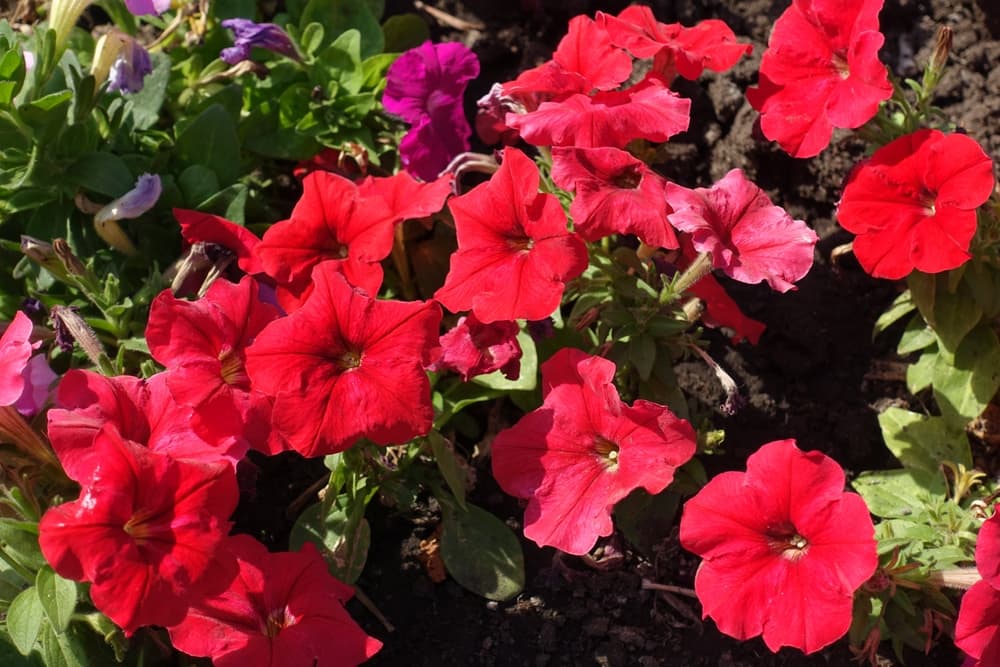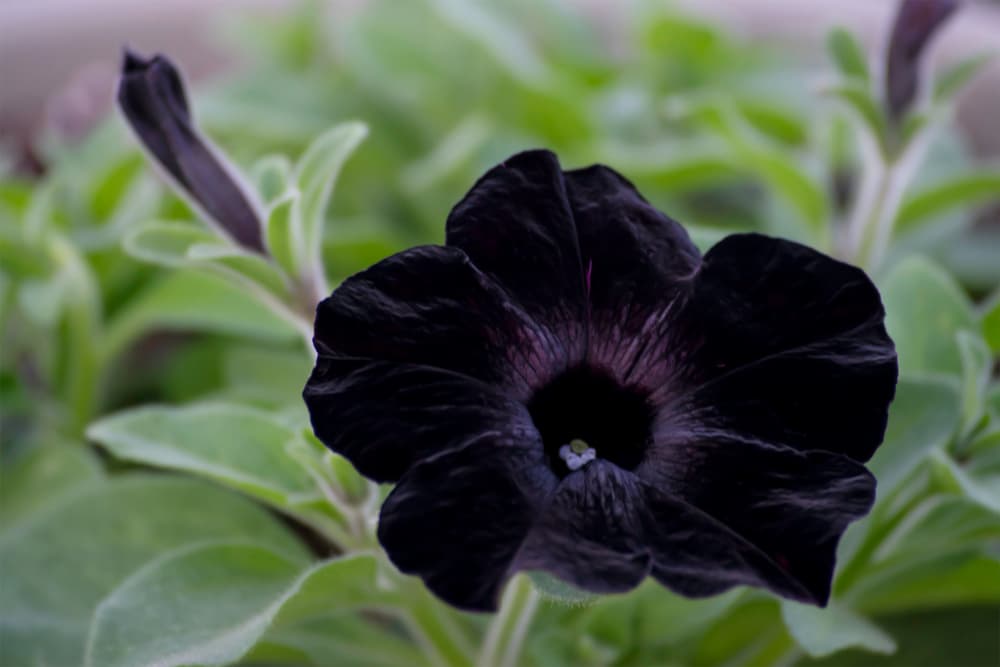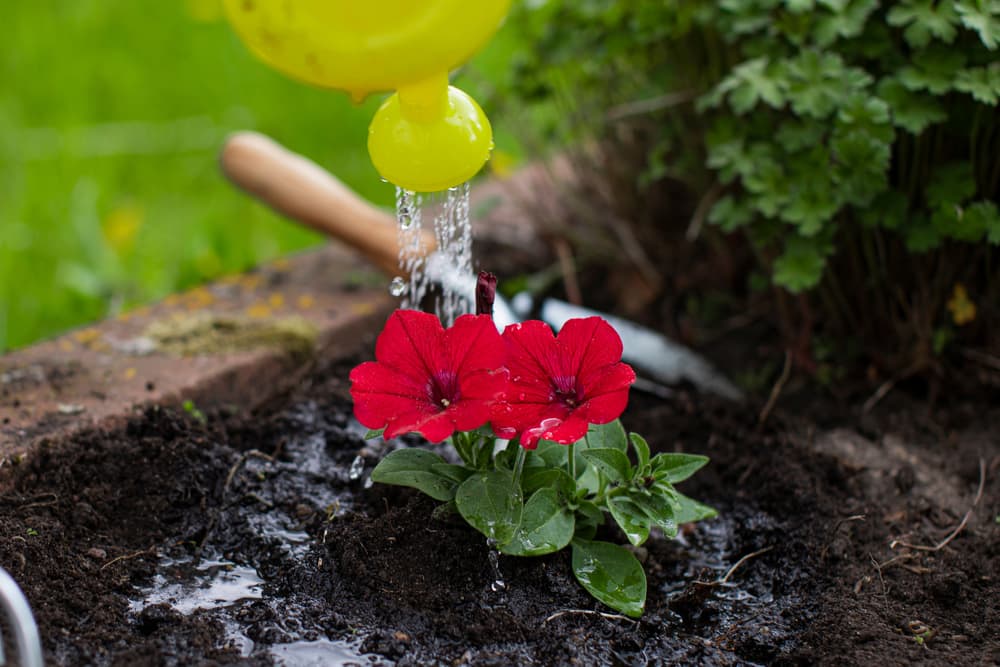ANNUALS > PETUNIA
Chris is a gardening writer and nature enthusiast. He graduated from Oxford Brookes University in 2022 with an MA in Psychology. Chris works with the Leeds Green Action Society, helping their food cooperative by growing various fruit and vegetables on their two allotments in Hyde Park, Leeds.
Reviewed By COLIN SKELLY

Colin is a Horticulturist and Horticultural Consultant with experience in a range of practical and managerial roles across heritage, commercial and public horticulture. He holds the Royal Horticultural Society’s Master of Horticulture award and has a particular interest in horticultural ecology and naturalistic planting for habitat and climate resilience.
IN THIS GUIDE
Petunias are one of those plants that you can’t fail to notice everywhere in the UK.
These long-flowering beauties add vibrant bursts of colour throughout our gardens with the compact varieties being perfect for borders and beds, while the trailing types are a wonderful addition to hanging baskets.
Petunias come in a wide range of stunning colours, with choices between single and double blooms.
Many varieties even have their own unique fragrances.
Overview
| Botanical Name | Petunia |
| Plant Type | Annual / Perennial (these plants are naturally perennial but commonly grown as annuals in the UK) |
| Native Area | South America |
| Hardiness Rating | H2 |
| Foliage | Simple leaves |
| Flowers | Various colours, trumpet-shaped flowers |
| When To Sow | April, May, June |
| Flowering Months | June, July, August, September, October |
| When To Prune | July, August, September |
Sunlight
Preferred
Full Sun
Exposure
Sheltered
Size
Height
0.1 – 0.5M
Spread
0.1 – 0.5M
Bloom Time
June – October
Soil
Preferred
Loam, Sand
Moisture
Well drained
pH
Any
With so many options available, it’s easy to see why these pretty perennials are so well-loved, and why they make a choice for any garden whatever its size or style.
Why Grow Petunias?
Why are we so fond of petunias and their trumpet-shaped flowers?

Well, here are a few reasons I can think of:
- Petunias establish themselves quickly and easily.
- Caring for them is actually surprisingly easy, making them ideal for beginner and experienced gardeners alike.
- They are prolific flowerers, producing impressive amounts of blooms from June to October.
- They are low maintenance, making them really easy to care for.
- Petunias are well suited to pots, planters and containers. They won’t look out of place on an exterior windowsill, a patio container or hanging from a decking rail planter.
- With so many colours, sizes and shapes to choose from, it is easy to find the perfect petunias for any garden.
- Because of their easy-to-grow nature, they are a great option if you are hoping to introduce children to gardening.
“Petunias are popular for a reason,” says Master Horticulturist Colin Skelly.
“They flower for months on end and provide a burst of vibrant colour with relatively easy maintenance.
“They are perfect for pots and containers, which makes them ideal for beginners or children but also a quick win for the time-pressed or casual summer gardener.”
Petunia Varieties
There are hundreds of cultivars of petunias to choose from, so it can be hard to know where to start. Here are five of my personal favourites:
P. ‘Priscilla’

This double-flowering variety of petunia is wonderfully fragrant and has beautifully unique, large and heavily veined lilac blooms.
This pretty, purple plant has a long trailing habit, growing to up to 80cm in length, making it a superb choice for hanging baskets.
P. ‘Phantom’

This sleek, sophisticated and exceptionally eye-catching variety sport velvety black petals that, over time, develop star-like yellow patterns.
‘Phantom’ has a mounding, upright growth habit and is ideal for flower boxes which are sure to turn heads.
P. ‘Red Bingo’

This plucky little petunia produces bright red medium-sized blooms that add interest to your garden throughout the summer months.
Thanks to their compact, upright growth habit they are perfect for pots that can be placed on patios and decking
P. ‘Black Satin’

This petunia produces gorgeous deep purplish-black trumpets that bloom from late spring to late summer.
With their satin sheen and compact nature, they are ideal bedding plants and will really help to make the other colours in your garden pop.
P. ‘Star’

With blooms in shades of pink, red and purple, P. ‘Star’ is one of the most popular bi-coloured varieties.
Their whimsical style makes the perfect choice for gardeners who want to inject a bit of fun and gaiety into their garden.
Fresh and flamboyant, they are well suited to both formal and informal style gardens.
How To Grow Petunias
Including petunias in your garden can offer long-term colour to your garden’s landscape over the summer months.
Cultivation
Petunias adore sunshine, although they will tolerate light shade, and will perform best in moist, fertile, well-drained soil.
To prepare the soil, you will want to dig in lots of organic matter such as compost or well-rotted manure to make sure you really pack in the moisture.
Growing From Seed
Different varieties of petunias perform differently when sown from seeds so, if you want to plant from seed, it’s important to research which varieties will reward you the most.
Annual and bedding petunia seeds should be sown in spring.
When the plants seem to be comfortable outside and after the risk of frost has passed, you can then plant them in your chosen spot in your garden, containers, hanging baskets or window boxes.
Planting Out
The best time to plant petunias is between May and June when the risk of frost has well and truly passed.
You will want to use freshly prepared soil or balancing compost when planting petunias.

If you are planting in a basket or pot, we recommend planting three or four plugs per 30cm radius.
- Dig a decent-sized hole which will easily allow for the rootball of the plant.
- Next, add a layer of organic matter or compost to the base of the hole and fork it in thoroughly.
- You can then take the root ball and place it in the hole, making sure to adjust the depth so that it is at the same level that it was at in its original pot, taking care to make sure the roots are level with the soil surface.
- Mix in more compost or organic matter and gently fill in the hole.
- Next, we advise applying a layer of general granular feed and then water well – you may also wish to apply a 5cm layer of well-rotted garden compost, which will help you to lock in the moisture and help prevent the growth of weeds.
- To begin with water every 3-5 days, avoiding the foliage which can be easily damaged. Instead, water at the base close to the soil.
Take care to ensure that the pots have good drainage to prevent waterlogging and root rot.
You can check the moisture level of the soil before watering to be sure.

If you are lucky to have a greenhouse, you can place the little petunias in spring, allowing them to grow and then put them outside in June.
This will encourage earlier and longer flowering throughout summer.
Petunia Care
Sunshine is vital when it comes to growing healthy petunias.
Pick a sunny little spot in your garden, and your petunias will produce an abundance of glorious, beautiful blooms for you and your family to enjoy all throughout the summer months.
Watering
Petunias also require moist soil so, during dry spells, you will want to water regularly.
For petunias planted in containers watering may be needed on a daily basis to help them to thrive, but do take care not to overwater as this can result in the plants becoming leggy with far fewer flowers.

Spreading ground cover varieties are very particular about water and will require weekly watering to keep them healthy.
Feeding
Throughout the summer, we highly recommend feeding your petunias with liquid plant food.
This will encourage maximum production of flowers that will bloom for a much longer period.
Common Problems
They may look dainty, but petunias are tough cookies and can withstand a fair bit of neglect and poor weather conditions.
But, as with all plants, there are a number of pests and diseases that can cause all kinds of damage.
We’ve put together a list of the most common pests and diseases and how you can tackle them to keep your petunias happy and healthy.
Caterpillars
Humans may adore petunias, but caterpillars may well be their biggest fans.
These irritating creepy crawlies love to dine out on foliage and buds and, if left unchecked, can cause some fairly significant damage.

If you can face it, the best way to get rid of these beastly mini beasts is to pick them off by hand daily; you can then either release them into the wild, far from your garden or if absolutely necessary, drown them in a bucket.
If handpicking caterpillars sounds like too much of an ordeal, then weekly sprays of Bacillus thuringiensis will quickly and efficiently kill them off.
Mites
These microscopic monsters suck the juices out of the very cells of your petunias, this leads to the discolouration and hardening of flowers and can cause leaves to curl and cup.
Mites are cousins of spiders, and this means they leave telltale webs behind them as they feed.
If you notice these little trails, then treat your petunias with a spray of neem oil once a week until all signs of the mites have disappeared.
Thrips
Thrips can be difficult to see, but they have a similar appearance to ants.
These nasty little things can carry viruses that are harmful to petunias and cause flowers to develop white spots and leaves to appear papery and weak.
Thankfully, as with mites, neem oil can be employed to rid your plants of these pesky perpetrators.
Powdery Mildew
One of the most common reasons for powdery mildew to appear is plants being planted too close together.
Avoiding planting too tightly at the outset to help prevent mildew from striking.

If you do find yourself with a powdery mildew issue then, once again, neem oil applied weekly will help your petunias to become fighting fit once again.
Root, Stem & Crown Rot
Petunias planted in areas with poor drainage will frequently fall victim to root, stem and crown rot.
With regular watering, leaves will wilt and stems will become fragile.
Sadly, in most cases, the petunia won’t be able to be saved, and it may be better to pull them out and start again.
You can try and correct the drainage problem but, if you see the damage, it probably means the problem is too far gone to be salvaged.
Botrytis Blight
This nasty little disease can be identified by post and discolouration on flowers and leaves, and will eventually produce grey-brown spores.
This is another disease that thrives in wet bedding conditions so the best thing you can do is quit watering for a while.
You should then prune the damaged areas of the plant and clear away any fallen debris.
You can dry out the bed to prevent further infestation.
Petunias are such rewarding plants, and their endless elegance and bountiful blooms have made them one of the most popular plants on the planet.

